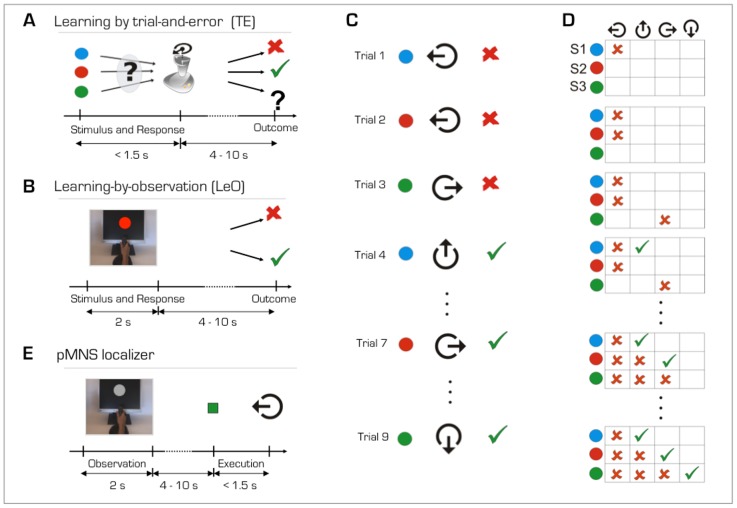Figure 1. fMRI task design.
(A) Learning by trial-and-error (TE). A trial started with the presentation of a coloured stimulus. Participants had to displace the joystick in one of the four possible directions (up, down, right and left) within 1.5 seconds. After a variable delay, a feedback stimulus was presented for 1 second indicating whether the action was correct (green tick), incorrect (red cross) or late (question mark). (B) Learning-by-observation (LeO). Each trial started with the presentations of a video showing a hand on a joystick performing one of the four possible movements in response to the presentation of a coloured stimulus on a monitor. The camera view was set to actor’s perspective. The video lasted 2 seconds and the coloured stimulus was presented for 1.5 seconds, as in the trial-and-error condition. The outcome images were presented after a variable delay and they were identical to those used in the TE condition. Participants were instructed to learn the correct stimulus-action-outcome associations by looking at the videos and outcomes. (C) Task design of an exemplar learning session. Stimuli were randomised in blocks of 3 trials. (D) Matrix of all possible stimulus-response combinations corresponding to the exemplar session in (C). Correct associations were not set a priori, but they were assigned as subjects advanced in the task. The first presentation of each stimulus was always followed by an incorrect outcome, irrespective of the motor response (from trial 1 to 3). On the second presentation of S1 (the blue circle), any untried joystick movement was always followed by a correct outcome (trial 4). The correct response for S2 and S3 (red and green circles, respectively) was found after 2 and 3 incorrect joystick movements (at trials 7 and 9, respectively). In other words, the correct response was the 2nd joystick movement (different from the first tried response) for stimulus S1, the 3rd joystick movement for stimulus S2, and the 4th for stimulus S3. This task design ensured a minimum number of incorrect trials during acquisition (one for S1, two for S2 and three for S3) and fixed representative steps during learning. The LeO task was built using a design similar to the one used for the TE learning task. Given the scarcity of repetition and maintenance errors in TE, in LeO the actor neither repeated incorrect actions while searching for the correct association (i.e. no repetition errors in the acquisition phase of learning), nor made errors after the first correct response (i.e. no maintenance errors). Therefore, learning-by-observation consisted in 6 incorrect (one for S1, two for S2 and three for S3) and 12 correct trials. (E) Observation and execution of actions. Participants observed a video of a hand performing a joystick movement in response to a grey stimulus (i.e. action observation). After a variable delay, subjects were instructed to perform the movement they had previously observed (i.e. action execution).

